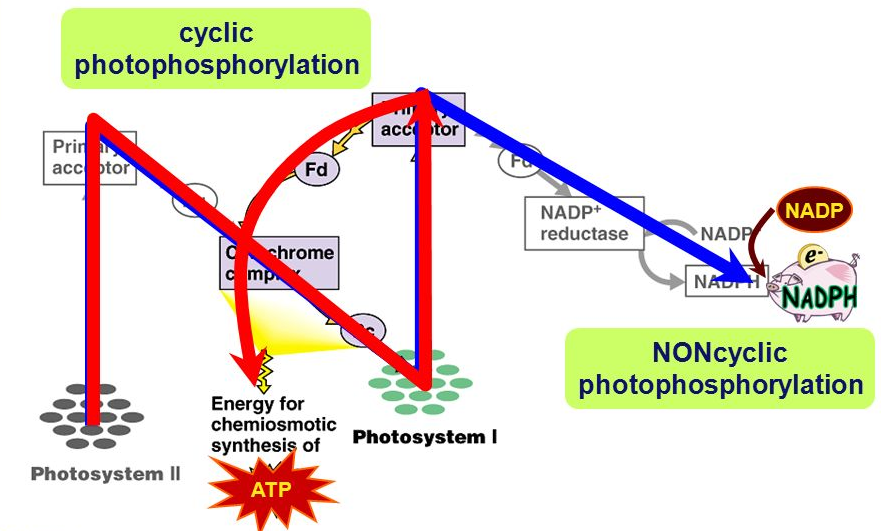Photophosphorylation is a characteristic phenomenon found in photosynthetic organisms. Photophosphorylation can be carried out by two pathways: Cyclic and Non-cyclic Photophosphorylation.
As the name suggests, photophosphorylation is a process through which organisms use sunlight to produce energy in the form of ATP and NADPH molecules. This process occurs exclusively in the specialized cell organelle called chloroplast, which is a characteristic feature of photosynthetic organisms.
This article will help you understand the main concepts and key difference between Cyclic and Non-cyclic photophosphorylation.

Index
What is cyclic Photophosphorylation
Cyclic photophosphorylation is the process of synthesis of ATP coupled with the ETS with the help of Photosystem I.
In this process, the excited electron is returned back to the excited chlorophyll molecule. Here, the P700 of Photosystem I absorbs light and the excited electron is transferred to the primary electron acceptor of PS I.
This primary electron acceptor further transfers this electron sequentially to Fe-S protein, ferredoxin, and cytochrome complex, and finally, it is returned back to excited chlorophyll of P700.
A molecule of ATP is generated via chemiosmosis in the Electron Transport Chain, without releasing any oxygen molecule or NADPH molecule. As the electron reaches back to its starting point, therefore this type of photophosphorylation is termed Cyclic. This form of photophosphorylation occurs in the stroma lamella.
What is Non-cyclic Photophosphorylation
The noncyclic photophosphorylation is the process of synthesis of ATP and NADPH coupled with ETS with the help of both Photosystems I and Photosystem II.
An electron from the P680 center of Photosystem II is excited, which gets transferred to the P700 center of Photosystem I and is not returned. As the electrons move in a constant non-cyclic pattern, hence the name Non-Cyclic Photophosphorylation. Being a light reaction, non-cyclic photophosphorylation occurs in the thylakoid membrane.
Difference Between Cyclic and Non-cyclic Photophosphorylation
Now that we have understood what exactly cyclic and non-cyclic photophosphorylation is, let’s look at this table which highlights all the key difference between the two processes:
| Cyclic Photophosphorylation | Non-cyclic Photophosphorylation |
|---|---|
| Only PS I is involved in this. | Both PS I and PS II are involved in this. |
| The reaction center i.e. Chl a is P700. | The reaction center i.e. Chl a is P680. |
| There is no photolysis of water. | There is photolysis of water with the help of an oxygen-evolving complex. |
| The products obtained are ATP only. | The products obtained are both ATP and NADPH + H+. |
| The electrons lost from the reaction center are cycled back and returned to the source. | The electrons lost from the reaction center are not cycled back but compensated by the photolysis of water. |
| Takes place in the stroma of the thylakoid. | .Takes place in the grana of the thylakoid. |
FAQs
Photosystem I and photosystem II differ in the wavelength of light absorbed by them. PS I is efficient in absorbing light of wavelengths larger than 680nm, while PS II is efficient in absorbing light of wavelengths shorter than 680nm.
ATP and NADPH are both obtained in the light reaction phase via the process of non-cyclic photophosphorylation.
